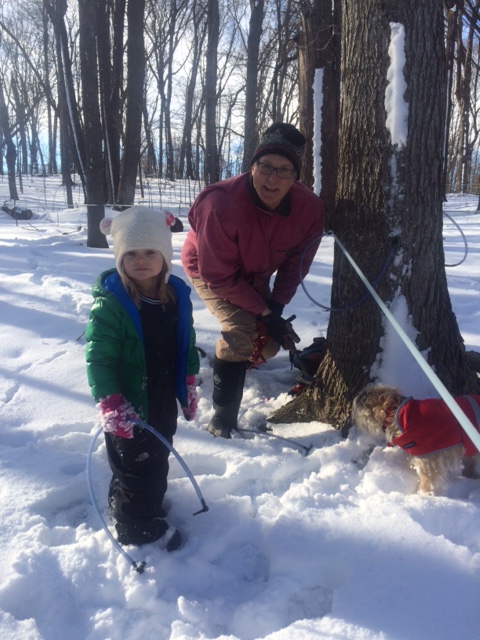
We took advantage of the warm weekend of February 6-7 and got all of our approximately 900 taps in. For each tap, we drilled a 5/16" hole about 2 inches into the tree. Most trees have one tap, but some of the larger trees have two. It is important to drill a circular hole, not allowing the drill bit to wander and enlarge the opening to an oval. After the hole is checked for wood shavings and cleaned with a stick if necessary, a new plastic attachment, called a check-valve spile adapter, is inserted into the hole. Then we attach the "drop line", which is the piece of tubing that connects the spile adapter to the 5/16" plastic tubing that flows downhill to the tank. In the picture above, you can see Greta holding a drop line. On occasion we have to replace a drop line because a squirrel damages it. The drop line and check valve are then pounded into the tree. creating a tight seal. This goes back to the importance of the circular hole. It is important that the check valve seals the hole completely because all of the tubing is connected to a vacuum pump that helps pull the sap out of the tree. If the seal isn't good, our vacuum pressure at the trees is lower and we get less sap.
The extended forecast looks like sap could start flowing towards the end of the week. It is always hard to predict early season runs, but since this winter has been warmer than average, we are optimistic that sap will flow pretty well at the beginning of the season. We did see some sap dripping out of the holes we were drilling on the south sides of the trees on the 7th. This week and weekend, we will finish connecting all of the other parts needed to collect the sap: the vacuum releaser, sap lifters and moisture traps. We will clean the tanks and hopefully start collecting sap. Once the vacuum is on, the next step will be to search the woods for leaks in the lines that we were unable to detect when we were putting taps in.